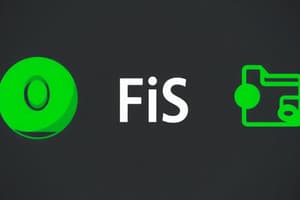Podcast
Questions and Answers
Which operating system service is most directly responsible for allowing a user to interact with the system using visual elements such as windows and icons?
Which operating system service is most directly responsible for allowing a user to interact with the system using visual elements such as windows and icons?
- Graphics User Interface (GUI) (correct)
- File-system manipulation
- Program Execution
- Command-Line Interface (CLI)
A user attempts to launch a program, but the operating system denies the request due to insufficient memory. Which operating system service is primarily involved in this scenario?
A user attempts to launch a program, but the operating system denies the request due to insufficient memory. Which operating system service is primarily involved in this scenario?
- File-system manipulation
- User interface
- I/O operations
- Program execution (correct)
An application needs to save data to a file on the hard drive. Which operating system service manages this interaction?
An application needs to save data to a file on the hard drive. Which operating system service manages this interaction?
- User interface
- Program execution
- File-system manipulation
- I/O operations (correct)
A user wants to view a list of all files in a specific folder and their sizes. Which operating system service provides this functionality?
A user wants to view a list of all files in a specific folder and their sizes. Which operating system service provides this functionality?
Which type of user interface relies primarily on typed commands?
Which type of user interface relies primarily on typed commands?
Which operating system service is essential for setting permissions on files, dictating which users can read, write, or execute them?
Which operating system service is essential for setting permissions on files, dictating which users can read, write, or execute them?
A script is designed to automatically process a series of commands without user interaction. Which type of user interface is likely being utilized?
A script is designed to automatically process a series of commands without user interaction. Which type of user interface is likely being utilized?
Which of the following scenarios best describes the 'program execution' operating system service?
Which of the following scenarios best describes the 'program execution' operating system service?
Which communication method involves the operating system moving data in discrete units between processes?
Which communication method involves the operating system moving data in discrete units between processes?
In the context of OS services, what is the primary goal of 'protection'?
In the context of OS services, what is the primary goal of 'protection'?
Why is accounting a crucial operating system service in a multi-user environment?
Why is accounting a crucial operating system service in a multi-user environment?
Which of the following resources requires specific rather than general allocation code in an operating system?
Which of the following resources requires specific rather than general allocation code in an operating system?
Which service is most closely related to preventing unauthorized access to resources?
Which service is most closely related to preventing unauthorized access to resources?
What is the key difference between protection and security in the context of operating systems?
What is the key difference between protection and security in the context of operating systems?
Which of the following is a characteristic of the GUI?
Which of the following is a characteristic of the GUI?
What is the role of a 'command interpreter' in an operating system?
What is the role of a 'command interpreter' in an operating system?
Why might an operating system implement both CLI and GUI interfaces?
Why might an operating system implement both CLI and GUI interfaces?
What is the most accurate definition of a 'system call'?
What is the most accurate definition of a 'system call'?
Flashcards
Operating System Services
Operating System Services
An environment for program execution and services to programs and users.
User Interface (UI)
User Interface (UI)
Allows users to interact with the operating system.
Program Execution
Program Execution
Loading a program into memory and running it.
I/O Operations
I/O Operations
Signup and view all the flashcards
File-System Manipulation
File-System Manipulation
Signup and view all the flashcards
Command-Line Interface (CLI)
Command-Line Interface (CLI)
Signup and view all the flashcards
Graphical User Interface (GUI)
Graphical User Interface (GUI)
Signup and view all the flashcards
Batch Processing
Batch Processing
Signup and view all the flashcards
OS Communications
OS Communications
Signup and view all the flashcards
OS Error Detection
OS Error Detection
Signup and view all the flashcards
OS Resource Allocation
OS Resource Allocation
Signup and view all the flashcards
OS Accounting
OS Accounting
Signup and view all the flashcards
OS Protection
OS Protection
Signup and view all the flashcards
OS Security
OS Security
Signup and view all the flashcards
Debugging Facilities
Debugging Facilities
Signup and view all the flashcards
Process Isolation
Process Isolation
Signup and view all the flashcards
System Call
System Call
Signup and view all the flashcards
Application Program Interface (API)
Application Program Interface (API)
Signup and view all the flashcards
Win32 API
Win32 API
Signup and view all the flashcards
POSIX API
POSIX API
Signup and view all the flashcards
Java API
Java API
Signup and view all the flashcards
Shell
Shell
Signup and view all the flashcards
Study Notes
Operating System Services
- Operating systems create an environment for programs to execute and provide services to programs and users.
- OS services provide user functions such as user interface (UI), varying between Command-Line (CLI), Graphics User Interface (GUI), and Batch.
- Program execution: systems must load and run programs and end execution normally or with errors.
- I/O operations involve file or I/O device interaction.
- File-system manipulation: programs should be able to read, write, create, delete, search, list file information and manage permissions for files and directories.
- Processes can exchange information either on the same computer or across a network.
- Communications can occur via shared memory or through message passing, where packets are moved by the OS.
- Error detection is a constant OS task for CPU, memory hardware, I/O devices, and user program errors.
- The OS should act appropriately to ensure correct computing for each error.
- Debugging facilities can greatly improve user and programmer system efficiency.
- Another set of OS functions ensure that resource sharing makes the system operate efficiently.
- Resource allocation is required when multiple users or jobs run concurrently for resources like CPU cycles, main memory, and file storage, which may need special allocation code.
- Other resources like I/O devices require general request and release code.
- Accounting tracks how much and what kinds of computer resources are used.
- Protection and security measures are needed to control information use in multi-user or networked systems, preventing interference between concurrent processes.
- Protection ensures that all access to system resources is controlled.
- System security from outsiders involves user authentication and defending against invalid access attempts on external I/O devices.
User Operating System Interface
- Command Line Interface (CLI), or a command interpreter, allows direct command entry.
- The CLI is sometimes implemented in the kernel or as a systems program, and multiple flavors (shells) are available.
- CLI primarily fetches a command from the user and executes it, and commands can be built-in or programs.
- Adding new features does not require shell modification if the commands are programs.
- User-friendly desktop metaphor interfaces use a mouse, keyboard, and monitor
- Icons represent files, programs, actions, etc.
- The interface has objects that when used with the mouse buttons cause actions like providing information, options, executing a function, or opening a directory or folder.
- Xerox PARC invented the GUI, now many systems include both CLI and GUI interfaces.
- Microsoft Windows uses GUI with CLI "command" shell.
- Apple Mac OS X uses an "Aqua" GUI interface with a UNIX kernel underneath with shells.
- Solaris uses a CLI with optional GUI interfaces like Java Desktop (KDE).
System Calls
- System calls are the programming interface for OS-provided services.
- System calls are typically written in a high-level language like C or C++.
- System calls are mostly accessed by programs through a high-level Application Program Interface (API) instead of direct system calls.
- Three common APIs are Win32 API for Windows, POSIX API for Linux, UNIX, and Mac OS X, and Java API for the Java virtual machine (JVM).
- A system call sequence copies the contents of one file to another.
- Acquiring input file name, writing prompts to the screen and accepting input are all actions taken within this system.
- The system opens the input file, aborting if the file does not exist, and creates an output file, aborting if the file already exists.
- In a loop, the system reads from the input file, writes to the output file until reading fails, and then closes the output file.
- Finally, the system call sequence writes a completion message to the screen and terminates normally.
Studying That Suits You
Use AI to generate personalized quizzes and flashcards to suit your learning preferences.




